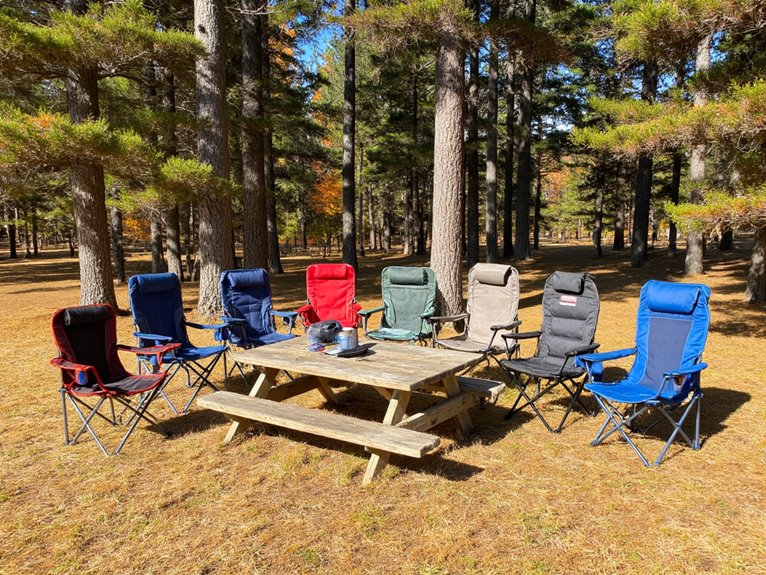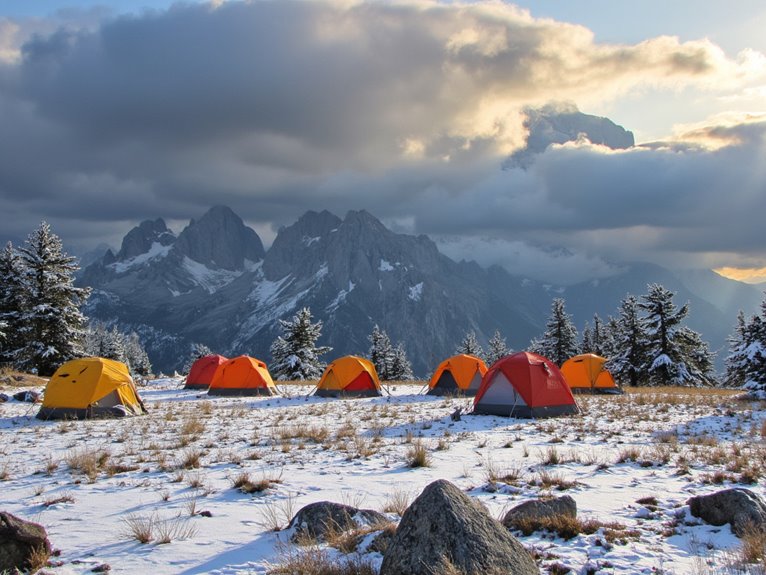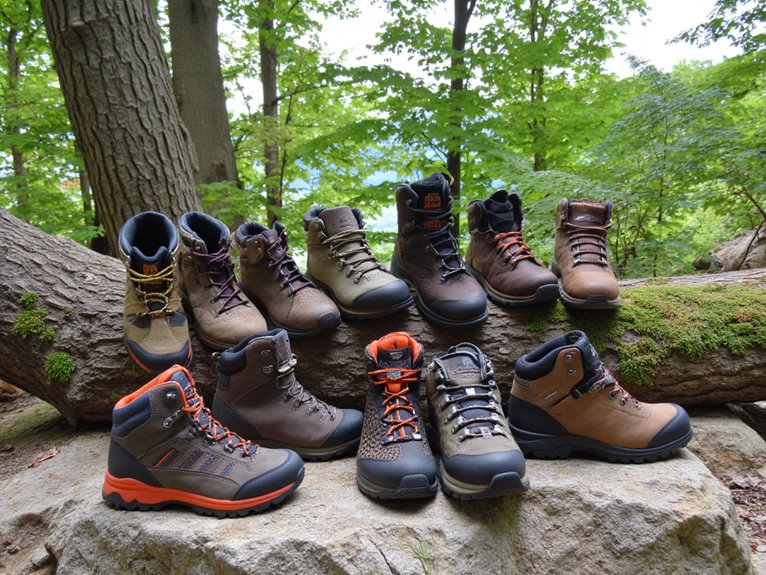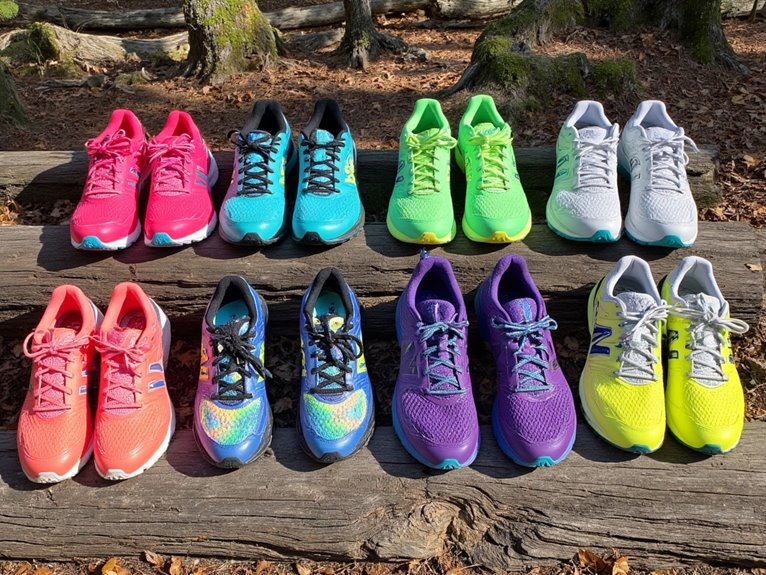Backpacking in Humid Climates: Gear & Moisture Management Tips
You’ll need moisture-wicking synthetic base layers, breathable rain jackets with 15,000+ g/m²/24hr ratings, and trail runners instead of waterproof boots for humid backpacking success. Implement a two-sock layering system using synthetic liners beneath merino wool outer socks, while rotating three to four pairs daily. Pack lightweight umbrellas for ventilation, permethrin-treated clothing for insect defense, and waterproof storage containers with silica gel desiccants. Proper gear selection and systematic moisture management strategies will transform your humid climate adventures.
We are supported by our audience. When you purchase through links on our site, we may earn an affiliate commission, at no extra cost for you. Learn more. Last update on 10th December 2025 / Images from Amazon Product Advertising API.
Notable Insights
- Choose lightweight rain gear like Simms ProDry jackets and ultralight umbrellas for superior moisture protection without added pack weight.
- Select moisture-wicking synthetic base layers and breathable outer shells rated 15,000+ g/m²/24hr for effective sweat management and ventilation.
- Use two-layer sock system with synthetic liner socks and merino wool outer socks, rotating pairs daily to prevent blisters.
- Protect equipment with airtight containers and silica gel desiccants, ensuring complete drying within 24-48 hours before storage.
- Pack humidity-specific items like anti-fungal powders, pH-balanced wipes, and permethrin-treated clothing for health and comfort maintenance.
Essential Rain and Weather Protection Equipment
When backpacking through humid climates, your rain and weather protection equipment becomes the critical barrier between comfort and misery on the trail.
Lightweight rain jackets like the Simms ProDry and Montbell Versalite offer essential moisture protection without adding excessive weight. The Frog Toggs Ultralite 2 provides proven waterproofing at minimal pack weight.
Premium lightweight rain jackets deliver critical moisture protection while maintaining minimal pack weight for serious backpackers.
Rain jacket alternatives include ultralight umbrellas. Six Moon Designs Silver Shadow and Montbell Trekking umbrellas deliver superior ventilation while maintaining rain protection.
Umbrellas excel in windy conditions where jackets fail.
Moisture protection accessories complete your system. Waterproof footwear like Merrell Moab 2 Mid prevents foot saturation. Gaiters block water entry at boot lines.
Lightweight rain covers protect backpack contents. Waterproof socks prevent blisters during extended wet conditions.
Moisture-Wicking Clothing Strategies for Hot, Humid Conditions
Your clothing choices in hot, humid conditions can make the difference between comfortable hiking and miserable slogging through sweat-soaked fabric.
Selecting the right moisture-wicking materials and achieving proper fit creates a foundation for thermal regulation, while strategic ventilation and layering systems maximize airflow and evaporation rates.
These two core strategies work together to move moisture away from your skin and accelerate drying times when temperatures soar and humidity levels climb above 70%.
Fabric Selection and Fit
Although cotton might seem like a natural choice for hot weather, synthetic materials like polyester and nylon outperform traditional fabrics in humid conditions by actively pulling moisture away from your skin.
These synthetics excel at fabric breathability while minimizing moisture absorption that leads to clingy, uncomfortable clothing.
Choose lightweight fabrics with loose fits for maximum airflow. Your garments should drape slightly away from your body rather than fitting snugly against skin.
Look for textured or woven fabrics that won’t cling when wet.
Merino wool offers a compromise between synthetics and natural fibers, providing decent moisture-wicking with odor resistance.
However, polyester and nylon remain superior for high-intensity backpacking activities where quick-drying properties become critical for comfort and temperature regulation in humid environments.
Ventilation and Layering Systems
Strategic ventilation becomes the foundation of effective moisture management in humid backpacking conditions. Your clothing’s airflow design directly impacts sweat evaporation rates and thermal comfort.
Implement these proven ventilation techniques to maximize breathability:
- Mesh panel integration: Strategic placement under arms and along side seams creates continuous air channels
- Zip ventilation systems: Underarm and back vents provide instant temperature regulation adjustments
- Fabric perforations: Laser-cut micro-holes enhance airflow without compromising fabric strength
Layering essentials require precise material selection for humid environments. Start with moisture-wicking synthetic base layers that pull sweat from skin surface.
Your mid-layer should feature lightweight, breathable construction—avoid insulation-focused options that trap heat.
Outer shells need wind resistance with high breathability ratings, typically 15,000+ g/m²/24hr for ideal moisture vapor transmission. This systematic approach prevents overheating while maintaining protection.
Optimal Footwear Selection and Foot Care Techniques
When selecting footwear for humid backpacking conditions, you’ll face a critical decision between trail runners and sandals, each offering distinct advantages for moisture management and terrain navigation.
Trail runners provide extensive foot protection and support while incorporating breathable mesh uppers and drainage systems, making them ideal for technical terrain where debris protection matters.
Your sock layering system becomes equally important—combining moisture-wicking synthetic liner socks beneath merino wool outer socks creates an effective barrier against blisters while maintaining dry conditions even when your feet get soaked during stream crossings.
Trail Runners Vs Sandals
Choosing between trail runners and sandals for humid climate backpacking requires evaluating your specific terrain, load weight, and moisture tolerance priorities.
Trail runners excel on technical terrain with moderate support and superior traction. They’re lighter than boots while providing essential toe protection. Non-waterproof versions dry faster than membrane-equipped models, reducing blister risk in humid conditions.
Hiking sandals maximize airflow and accommodate foot swelling effectively. They excel during water crossings and dry rapidly after exposure. However, they lack structural support and expose feet to debris.
Consider these performance factors:
- Terrain difficulty – Trail runners handle rocky, uneven surfaces better than sandals.
- Load weight – Heavier packs require trail runners’ enhanced support.
- Water exposure – Sandals dry fastest but offer minimal protection.
Trail runners balance protection, support, and breathability for most humid climate conditions.
Wet Sock Layering System
Because your feet face constant moisture exposure in humid climates, implementing a proper wet sock layering system becomes essential for preventing blisters, fungal infections, and trench foot.
This two-layer approach combines thin liner socks with thicker outer socks for ideal moisture management.
Choose synthetic liner sock types made from polyester or nylon that wick moisture efficiently without absorbing water. These materials transfer moisture outward to your outer sock layer.
Select merino wool or wool-blend outer socks that provide cushioning while offering antimicrobial properties and moderate moisture management.
Maintain three to four sock pairs minimum for rotation during extended trips.
Change into completely dry socks immediately upon reaching camp. Your feet need flexibility within this system—ensure socks allow comfortable toe movement to prevent pressure points and hotspots that lead to blisters.
Sun Protection and Insect Defense Gear
Although humid environments present dual challenges from intense solar radiation and aggressive insect populations, selecting the right protective gear can greatly improve your comfort and safety on the trail.
The right protective equipment transforms challenging humid trail conditions into manageable outdoor adventures with proper preparation.
Effective sun protection techniques begin with long-sleeve lightweight shirts featuring hoods and SPF 50+ ventilated hats. Light-colored woven fabrics reflect sunlight while hanging slightly off your body to promote airflow. Trekking umbrellas reduce temperature by 15-35°F underneath, considerably lowering sweat production.
For extensive protection, consider these essential items:
- Permethrin-treated clothing providing prolonged mosquito and tick defense
- Lightweight head nets for heavy insect activity zones
- High-SPF sunscreen with water resistance for exposed skin
Strategic insect repellent options include portable sprays, wipes, and clothing treatments that maintain effectiveness through humidity and perspiration.
Proper Gear Storage and Maintenance in High Humidity

Protecting your equipment extends far beyond field use—humid environments attack stored gear with relentless moisture that breeds mold, corrodes metal components, and breaks down synthetic materials through hydrolysis. Effective gear organization requires systematic cleaning techniques before storage.
| Storage Method | Moisture Protection | Best For |
|---|---|---|
| Airtight containers | Complete seal + desiccants | Electronics, metal items |
| Heavy-duty bags | Water-resistant barrier | Sleeping bags, clothing |
| Ventilated areas | Air circulation | Large equipment |
Clean all equipment with mild, specialized cleaners immediately after use. Remove every trace of dirt and debris that can trap moisture. Guarantee complete drying before storage—even minimal dampness triggers mold growth within 24-48 hours. Apply lubricants to zippers and moving parts. Include silica gel desiccants in containers. Store gear in temperature-controlled environments when possible to minimize hydrolysis damage. For sleeping bags specifically, conduct a thorough post-cleaning inspection for damage before storage, examining zippers, seams, and insulation to prevent moisture-related deterioration.
Hygiene Essentials for Humid Environment Backpacking

When humidity levels exceed 70%, your body’s natural cooling system becomes dramatically less efficient, creating a breeding ground for bacteria and fungi that thrive in perpetually moist conditions.
Your hygiene kits must adapt accordingly. Moisture management becomes critical for preventing infections and maintaining comfort during extended trips.
Essential items for humid environment backpacking include:
- Moisture-wicking base layers made from merino wool or synthetic fibers that pull sweat away from skin
- pH-balanced wipes for maintaining intimate hygiene when water sources are unavailable or contaminated
- Antimicrobial clothing treatments that prevent bacterial buildup in perpetually damp garments
Pack travel-sized toothbrush, biodegradable soap, and hand sanitizer as non-negotiables.
Rotate clothing daily and inspect skin regularly for early infection signs.
Your feet require particular attention—fungal infections develop rapidly in humid conditions.
Emergency Preparedness and Lightweight Safety Equipment
Humid environments amplify every emergency scenario you’ll encounter on the trail, turning minor setbacks into potentially life-threatening situations.
Satellite messengers and personal locator beacons provide reliable SOS functionality beyond cellular coverage. Pack two navigation methods—GPS devices with offline maps and traditional compass—for redundancy in dense vegetation. Store all electronics in waterproof cases to prevent moisture damage.
Your first aid kit requires humidity-specific additions: anti-fungal powders, insect bite treatments, and electrolyte supplements. Compact water filters convert contaminated sources into safe drinking water when supplies run low.
Emergency signaling equipment includes waterproof ferro rods, reflective mirrors, and bright LED lights for rescuer visibility through thick canopy. Ultralight tarps and mosquito nets provide essential shelter without weight penalties.
Preload emergency contacts into communication devices before departure.







